Spring Boot腾讯云短信
dreaming9420 人气:01.在pom.xml文件中添加依赖
<dependency>
<groupId>com.tencentcloudapi</groupId>
<artifactId>tencentcloud-sdk-java</artifactId>
<version>3.1.270</version>
</dependency>
2.新建SmsConstant常量类保存需要用到的常量
public class SmsConstant {
public static final String SDKAPPID = "";
public static final String SECRETID = "";
public static final String SECRETKEY = "";
public static final String SIGNNAME = "";
public static final String TEMPLATEID = "";
}
下面说明一下以上各个值如何获取
2.1.点击进入腾讯云短信服务官网
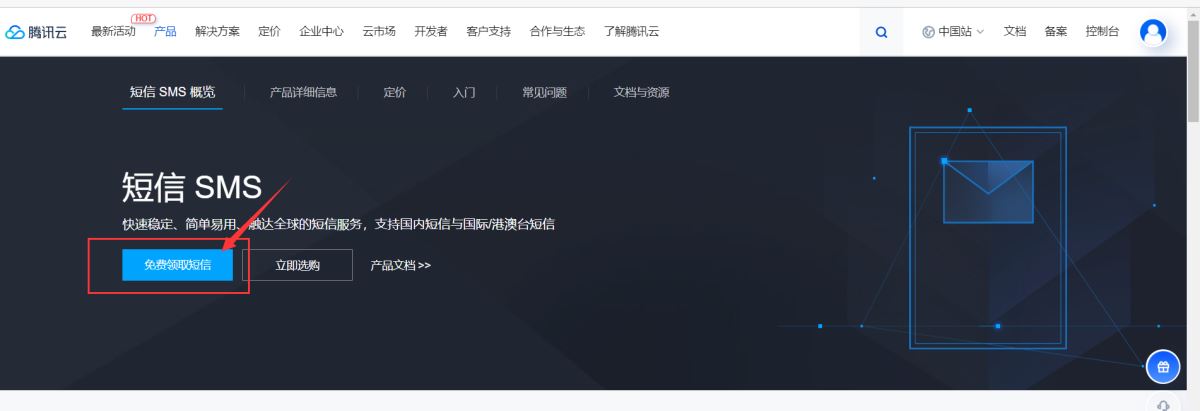
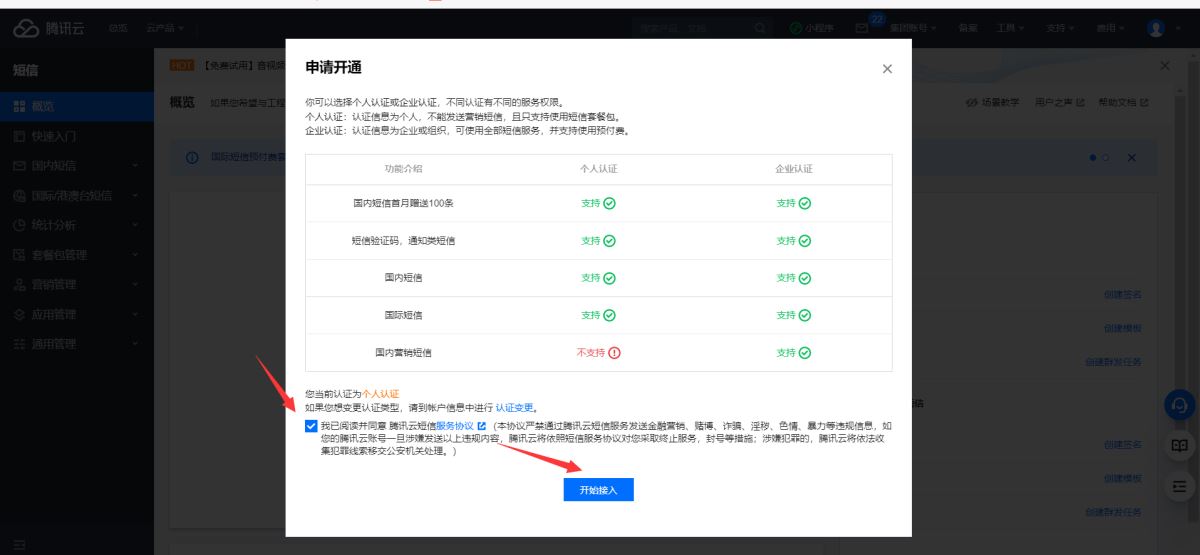
2.2.点击进入腾讯云短信控制台
SDKAPPID 就是下图中的SDKAppID,没有就创建
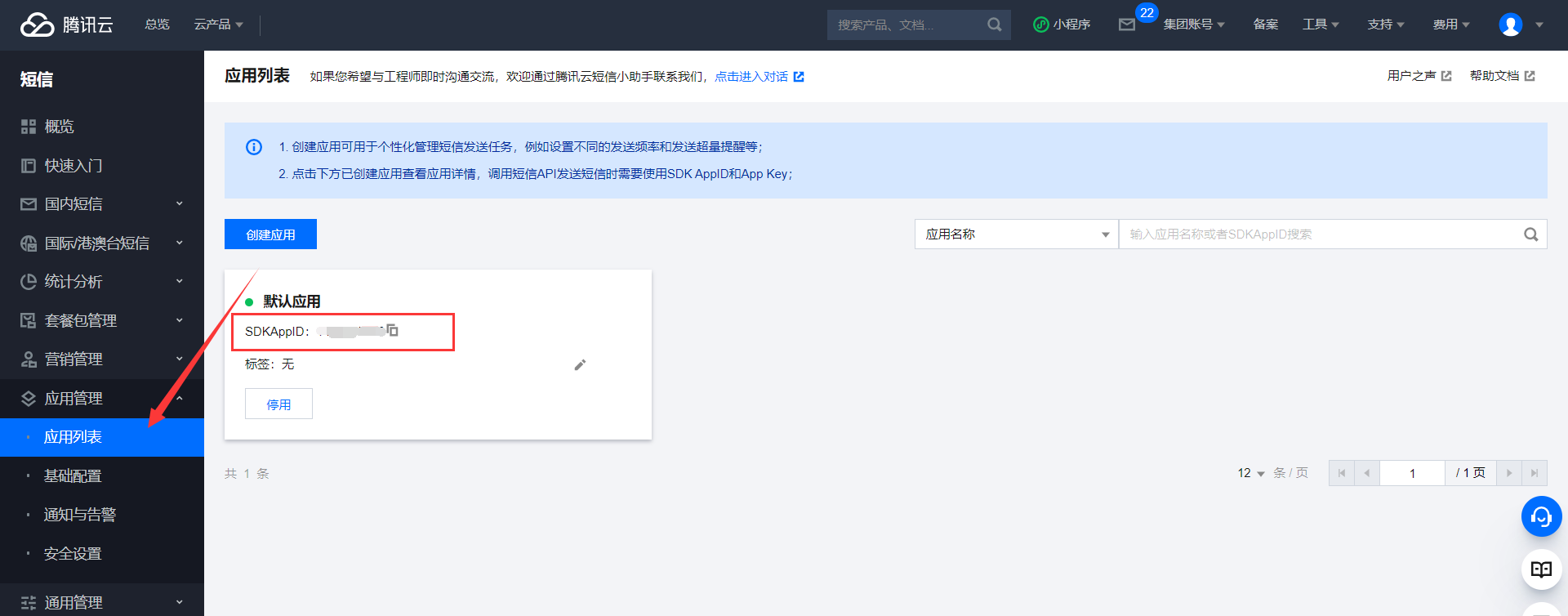
2.3.点击进入 API密钥管理
SECRETID 和SECRETKEY 就是下图中的SecretID 和 SecretKey

2.4.创建签名,等待审核

SIGNNAME 就是下图中的内容
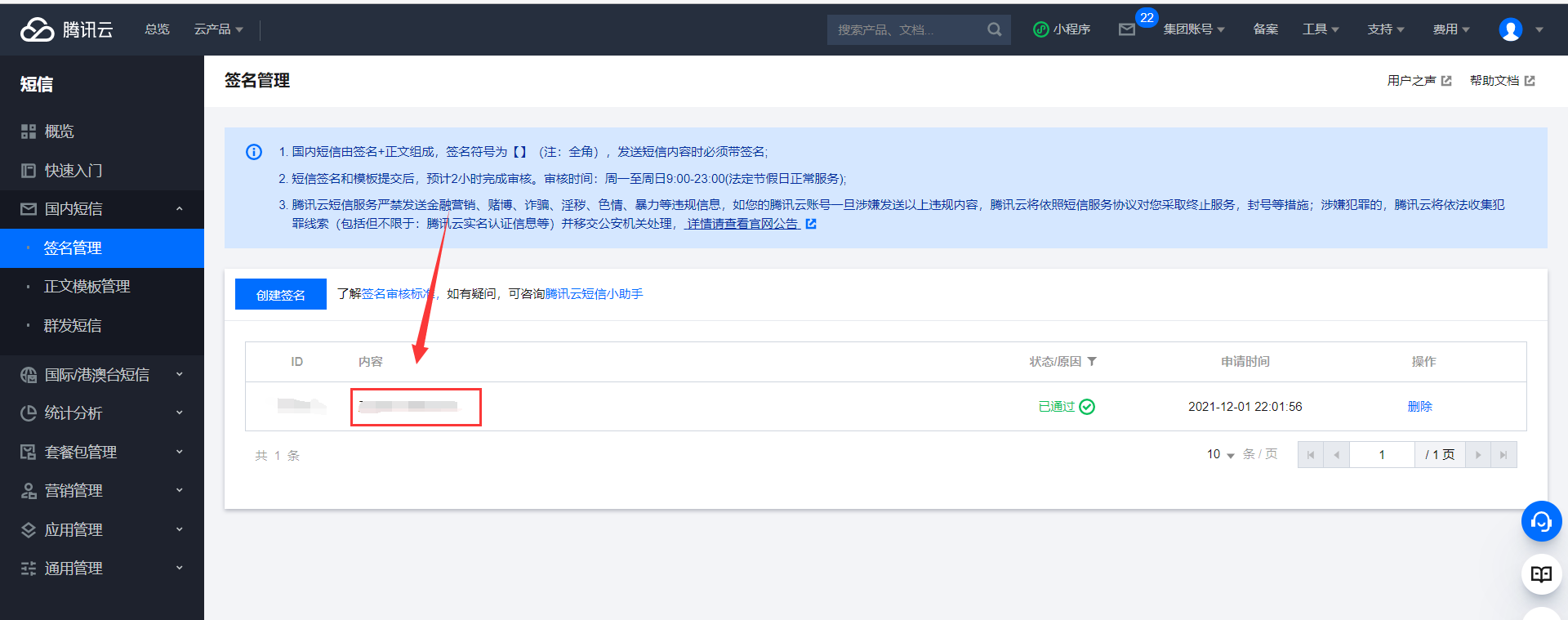
2.5.创建正文模板,等待审核
TEMPLATEID 就是下图中的ID
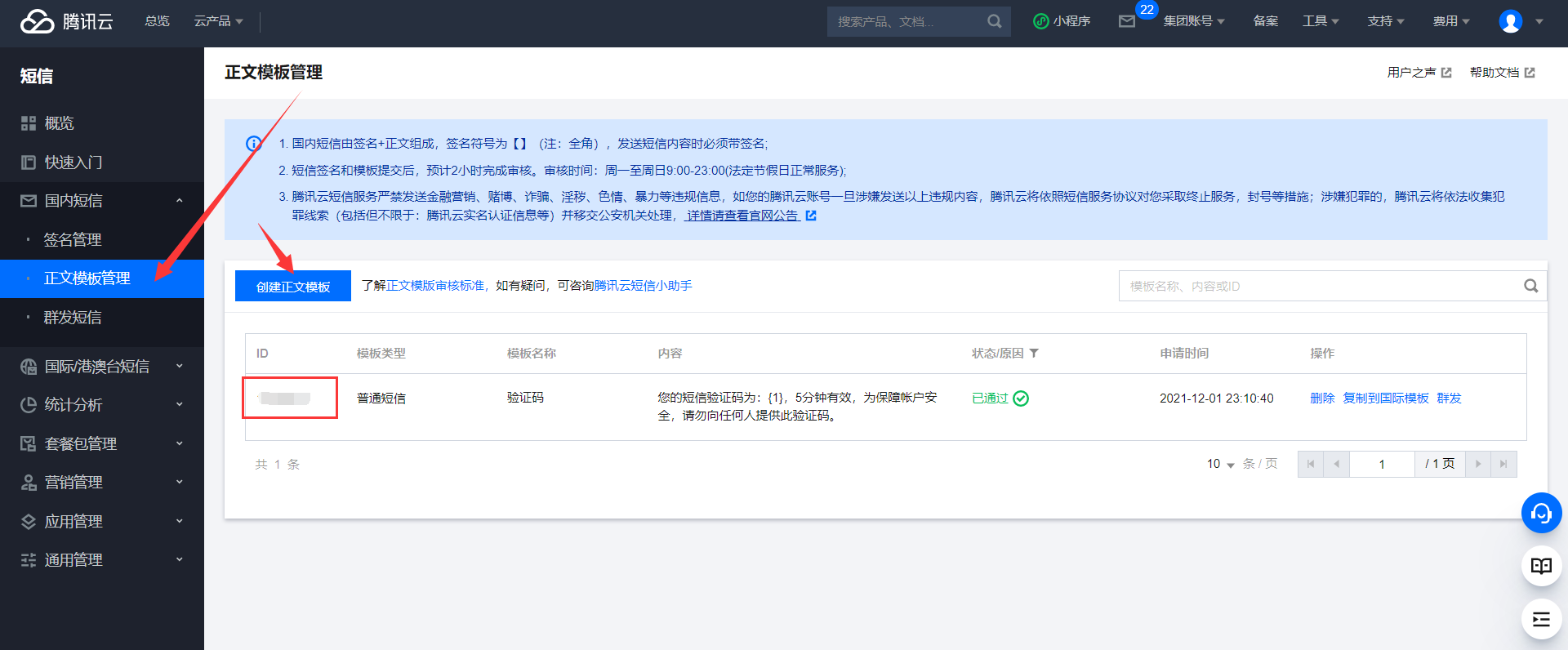
3.新建SendSmsUtil工具类
import com.admin.common.constant.SmsConstant;
import com.tencentcloudapi.common.Credential;
import com.tencentcloudapi.common.exception.TencentCloudSDKException;
//导入可选配置类
import com.tencentcloudapi.common.profile.ClientProfile;
import com.tencentcloudapi.common.profile.HttpProfile;
// 导入对应SMS模块的client
import com.tencentcloudapi.sms.v20210111.SmsClient;
// 导入要请求接口对应的request response类
import com.tencentcloudapi.sms.v20210111.models.SendSmsRequest;
import com.tencentcloudapi.sms.v20210111.models.SendSmsResponse;
public class SendSmsUtil {
public static void sendSms(String phoneNumber, String verificationCode) {
try {
/* 必要步骤:
* 实例化一个认证对象,入参需要传入腾讯云账户密钥对secretId,secretKey。
* 这里采用的是从环境变量读取的方式,需要在环境变量中先设置这两个值。
* 你也可以直接在代码中写死密钥对,但是小心不要将代码复制、上传或者分享给他人,
* 以免泄露密钥对危及你的财产安全。
* CAM密匙查询: https://console.cloud.tencent.com/cam/capi*/
Credential cred = new Credential(SmsConstant.SECRETID, SmsConstant.SECRETKEY);
// 实例化一个http选项,可选,没有特殊需求可以跳过
HttpProfile httpProfile = new HttpProfile();
// 设置代理
// httpProfile.setProxyHost("真实代理ip");
// httpProfile.setProxyPort(真实代理端口);
/* SDK默认使用POST方法。
* 如果你一定要使用GET方法,可以在这里设置。GET方法无法处理一些较大的请求 */
httpProfile.setReqMethod("POST");
/* SDK有默认的超时时间,非必要请不要进行调整
* 如有需要请在代码中查阅以获取最新的默认值 */
httpProfile.setConnTimeout(60);
/* SDK会自动指定域名。通常是不需要特地指定域名的,但是如果你访问的是金融区的服务
* 则必须手动指定域名,例如sms的上海金融区域名: sms.ap-shanghai-fsi.tencentcloudapi.com */
httpProfile.setEndpoint("sms.tencentcloudapi.com");
/* 非必要步骤:
* 实例化一个客户端配置对象,可以指定超时时间等配置 */
ClientProfile clientProfile = new ClientProfile();
/* SDK默认用TC3-HMAC-SHA256进行签名
* 非必要请不要修改这个字段 */
clientProfile.setSignMethod("HmacSHA256");
clientProfile.setHttpProfile(httpProfile);
/* 实例化要请求产品(以sms为例)的client对象
* 第二个参数是地域信息,可以直接填写字符串ap-guangzhou,或者引用预设的常量 */
SmsClient client = new SmsClient(cred, "ap-guangzhou", clientProfile);
/* 实例化一个请求对象,根据调用的接口和实际情况,可以进一步设置请求参数
* 你可以直接查询SDK源码确定接口有哪些属性可以设置
* 属性可能是基本类型,也可能引用了另一个数据结构
* 推荐使用IDE进行开发,可以方便的跳转查阅各个接口和数据结构的文档说明 */
SendSmsRequest req = new SendSmsRequest();
/* 填充请求参数,这里request对象的成员变量即对应接口的入参
* 你可以通过官网接口文档或跳转到request对象的定义处查看请求参数的定义
* 基本类型的设置:
* 帮助链接:
* 短信控制台: https://console.cloud.tencent.com/smsv2
* sms helper: https://cloud.tencent.com/document/product/382/3773 */
/* 短信应用ID: 短信SdkAppId在 [短信控制台] 添加应用后生成的实际SdkAppId,示例如1400006666 */
String sdkAppId = SmsConstant.SDKAPPID;
req.setSmsSdkAppId(sdkAppId);
/* 短信签名内容: 使用 UTF-8 编码,必须填写已审核通过的签名,签名信息可登录 [短信控制台] 查看 */
String signName = SmsConstant.SIGNNAME;
req.setSignName(signName);
/* 国际/港澳台短信 SenderId: 国内短信填空,默认未开通,如需开通请联系 [sms helper] */
String senderid = "";
req.setSenderId(senderid);
/* 用户的 session 内容: 可以携带用户侧 ID 等上下文信息,server 会原样返回 */
String sessionContext = "xxx";
req.setSessionContext(sessionContext);
/* 短信号码扩展号: 默认未开通,如需开通请联系 [sms helper] */
String extendCode = "";
req.setExtendCode(extendCode);
/* 模板 ID: 必须填写已审核通过的模板 ID。模板ID可登录 [短信控制台] 查看 */
String templateId = SmsConstant.TEMPLATEID;
req.setTemplateId(templateId);
/* 下发手机号码,采用 E.164 标准,+[国家或地区码][手机号]
* 示例如:+8613711112222, 其中前面有一个+号 ,86为国家码,13711112222为手机号,最多不要超过200个手机号 */
String[] phoneNumberSet = {"+86" + phoneNumber};
req.setPhoneNumberSet(phoneNumberSet);
/* 模板参数: 若无模板参数,则设置为空 */
String[] templateParamSet = {verificationCode};
req.setTemplateParamSet(templateParamSet);
/* 通过 client 对象调用 SendSms 方法发起请求。注意请求方法名与请求对象是对应的
* 返回的 res 是一个 SendSmsResponse 类的实例,与请求对象对应 */
SendSmsResponse res = client.SendSms(req);
// 输出json格式的字符串回包
System.out.println(SendSmsResponse.toJsonString(res));
// 也可以取出单个值,你可以通过官网接口文档或跳转到response对象的定义处查看返回字段的定义
System.out.println(res.getRequestId());
} catch (TencentCloudSDKException e) {
e.printStackTrace();
}
}
}
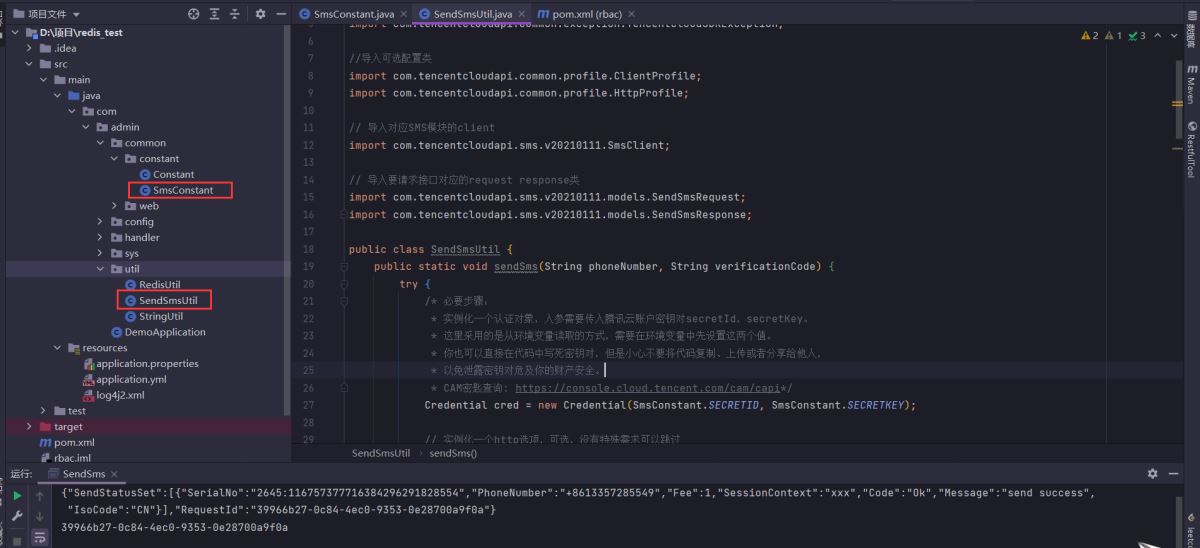
加载全部内容